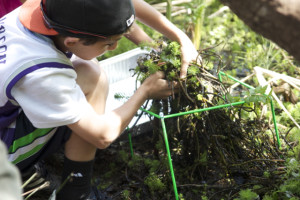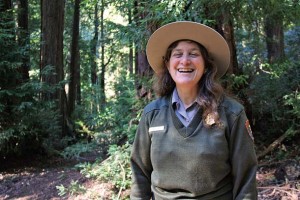Since 1999, students at Pinole Valley High School’s Environmental Studies Academy have been taking their college prep program through an environmental lens and getting a crash course in community action along the way. They’re partnering with other groups to provide environmental services that affect their whole human and biotic community.
“We love to come to work because of the academy,” says English teacher Leslie Ganick-Wilson, speaking to me at the academy’s recent annual meeting. “We collaborate across disciplines and grades, and through their projects students develop a real sense of independence.”
All the academy’s students (60 sophomores, 33 juniors, and 33 seniors) have been considered “at risk” because of attendance, economic background, standardized test scores, or poor progress toward graduation. But things change once they are in the program. “Their attendance is above the norm, their graduation rate is higher than average, grades improve over time, and acceptance rates to 4-year colleges are higher than the rest of the school,” says Dr. William Wilson, who teaches biology, ecology, and environmental studies. “And our drop-out rate is very low.”
Graduate Leah J. Clark went on to graduate from San Francisco State University and is now a budget analyst for the City of Richmond. She credits the academy for her success. “The integrated classes, the constant learning process, the opportunity to see things outside of school, are all great preparation for college,” she says.
One of the students’ target projects is the restoration of Pinole Creek, which runs right near the school. Mentored by staff from the nonprofit Earth Team, students pick up waste, remove invasive plants, and replace them with natives. The goal is to make the creek a healthier waterway. “Steelhead were seen just two years ago on this creek,” says Wilson. “Even ten to fifteen years ago they could easily be seen off Alhambra Valley Road. Historically, we had two- to three-hundred adults per creek.” Student Tianna Katsui and her group plan to help place storm drain filters to keep the creek cleaner, and, she says, “We’re going to Point Reyes and Muir Beach to see what healthy streams look like.” At the mouth of Pinole Creek, students monitor tunicates, also known as sea squirts, as part of a Smithsonian Institute program to track the health of the stream.
The students also collect and recycle batteries, cell phones, ink cartridges, and Capri Sun containers, in association with the RecycleMore program run by the West Contra Costa Integrated Waste Management Authority.
Along the way, students begin to learn job skills like digital mapping and how to do waste and energy audits. They also make presentations to other students, the parent-teacher association, and the Pinole City Council.
But perhaps the biggest payoff is the connections students and teachers develop as the academy tackles such a diverse range of issues. “The teachers got me to like science and taught me to write,” says Clark. “And they were available even after graduation. I could always come back to visit and ask for help.”

.jpg)



